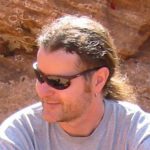Link to Pubmed [PMID] – 22206989
Link to DOI – 10.1016/j.jmb.2011.12.025
J Mol Biol 2012 Feb; 416(1): 148-61
We investigated the structure, properties and dynamics of the actin filament branch junction formed by actin-related protein (Arp) 2/3 complex using all-atom molecular dynamics (MD) simulations based on a model fit to a reconstruction from electron tomograms. Simulations of the entire structure consisting of 31 protein subunits together with solvent molecules containing ∼3 million atoms were performed for an aggregate time of 175 ns. One 75-ns simulation of the original reconstruction was compared to two 50-ns simulations of alternate structures, showing that the hypothesized branch junction structure is very stable. Our simulations revealed that the interface between Arp2/3 complex and the mother actin filament features a large number of salt bridges and hydrophobic contacts, many of which are dynamic and formed/broken on the timescale of the simulation. The simulations suggest that the DNase binding loops in Arp3, and possibly Arp2, form stabilizing contacts with the mother filament. Unbiased comparison of models sampled from the MD simulation trajectory with the primary experimental electron tomography data identified regions were snapshots from the simulation provide atomic details of the model structures and also pinpoints regions where the initial modeling based on the electron tomogram reconstruction may be suboptimal.
